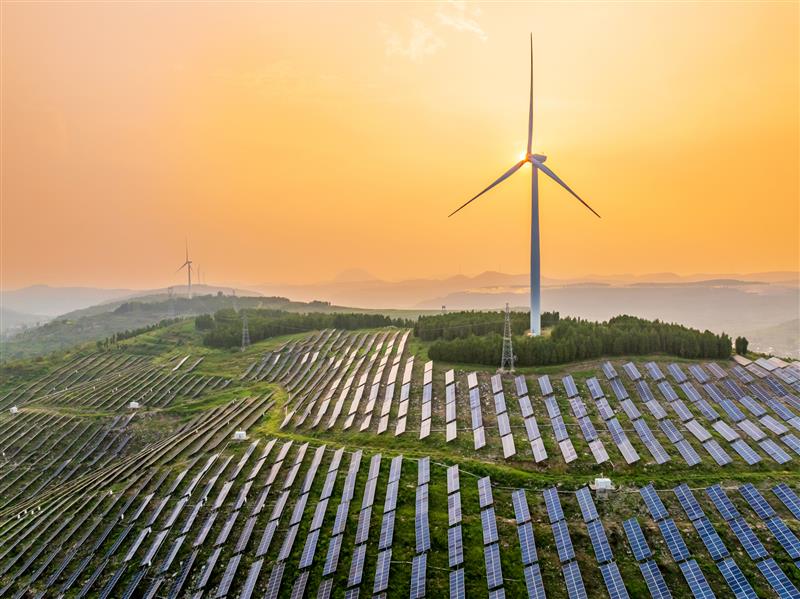How the UK solar sector can go further, faster.

On 21 April 2017, Londoners went about their day under haze and cloud; by evening the clouds temporarily dispersed and a waning crescent moon appeared above the city.1 The image was symbolic. That day, the UK's electricity supply was coal-free for 24 hours for the first time since the first coal-fired power station opened in 1882.2 Offshore wind generated over 6% of electricity in 2017 — up from less than 1% in 2010 — contributing to the combined electricity output from renewables of 29.4%, second only to gas.3
Fast forward to today and the UK is a world leader in offshore wind. The industry generates 17% of the UK’s electricity (see Figure 1)4 and makes up 18% of global installed capacity5. Moreover, the UK’s energy mix is completely coal-free and renewable energy, including onshore and offshore wind, solar and biomass, generates more than half (50.8%) of the UK’s electricity.6
This seismic shift away from coal (and increasingly from gas) didn't happen overnight. The offshore wind industry overcame multiple barriers – and is still developing, expanding and innovating.
We have been working with the offshore wind sector for the past 17 years and continue to partner with industry leaders across the value chain to enable impact. Many of the lessons learned from our experience collaborating with governments, developers and innovators to make offshore wind a viable commercial solution can be used to help the solar industry deliver impact.
Solar ambition
To achieve the UK’s mission for 95% clean power 2030, solar energy capacity needs to grow to 45 GW — nearly three times what it currently is (16.6 GW).7
In terms of capacity alone, solar is larger than offshore wind (14.8 GW), but where solar contributes -5%.8 of the UK’s annual total electricity generation, offshore wind accounts for -30%.9
Due to different operating parameters to offshore wind, including daylight hours, to generate the same level of energy the capacity of solar PV installed would need to be considerably higher than that of offshore wind.
The good news is that momentum is building for solar in the UK, where the record for maximum solar generation was recently broken on 1 April 2025, generating 12.2 GW between 12:30 and 13:00.10 And given the relative ease and lower costs to install than offshore wind, solar power is crucial to the UK’s 2030 plans.
Solar headwinds
Inevitably, the UK’s solar industry will face barriers to ramp up generation to 45 GW by 2030:
- Local opposition and concerns about land use
- The political push back against renewables, including the disintegration of the cross-party consensus on climate action11
- Concerns about labour rights in the solar supply chain (specifically in China)12
- Criticism of the lack of focus on ‘whole life’ emissions of solar development and associated concern about waste
- Physical risks to assets in the context of the escalating frequency and severity of extreme weather events that could lead to damage and/or reducing efficiency
- Transition risks, such as regulation (including the EU’s Carbon Border Adjustment Mechanism) which will impact the price of imports and exports of energy materials.
Tackling the challenges will require a blend of technological innovation (for example, circularity at the centre of design for solar equipment), effective engagement and communication (within the value chain and local communities) and policy and regulatory progress.
But what is the best way to achieve all this?
Lessons from wind – stronger together
When we consider the challenges faced by offshore wind compared to solar there are some commonalities and differences. The initial priority for wind was improving cost competitiveness to allow it to compete with existing fossil generation assets. Innovations supported through the Offshore Wind Accelerator contributed to a 15% reduction in the cost of energy for an average offshore wind project, saving industry a total of £34bn.13
For solar, the technology is already cheap. Deploying at scale responsibly, utilising brownfield sites and building rooftops and leveraging technology and innovation will be critical to success. And once installed, it is important that solar PV is managed through operation to maximise performance.
The broader lesson we can draw from our work with the offshore wind industry14 is that carefully designed collaboration can accelerate progress and save money by:
- Addressing challenges shared by the sector as a whole
- Providing a coherent voice to feed into enabling policy
- Enabling engagement across supply chains
- Agreeing common sectoral standards
A collaborative, collegiate approach means participants can benefit from:
- Sharing the cost, risk and reward of developing new technologies
- Creating a level playing field in terms of policy and regulation
- Avoiding the 'first mover disadvantage' which may come from being the first player in a sector to adopt a new approach
- Achieving critical mass to influence positive change
- Identifying and mitigating risks in the value chain
Sustainability JIP’s Offshore wind industry product carbon footprinting guidance
The Sustainability Joint Industry Programme (Phase 1) developed an industry-backed methodology15 and guidance on how to measure and address offshore wind farms’ carbon emissions throughout their lifecycle.
This guidance advises users on how to accurately calculate emissions using an inventory of offshore wind activity data and emission factors.
What does the guidance achieve?
- Provides sector specific guidance for the application of the relevant standards for Product Carbon Footprints (PCFs) to an offshore wind development.
- Provides guidance to harmonise the calculation approach within the industry, creating directly comparable and verifiable PCFs for OSW developments in terms of the electricity that they generate; enables stakeholders to confidently compare the impact of different developments.
- Provides a framework for developers to calculate and report different emissions metrics for their developments, including but not limited to:
- The GHG emissions & removals of the Offshore Wind development per reference unit (CO2e/unit)
- Absolute GHG emissions & removals of the Offshore Wind development broken down by lifecycle stage
- Absolute emissions & removals of the Offshore Wind development broken down by core assets and components in the infrastructure
- Provides a framework to improve data exchange throughout the Offshore Wind supply chain enabling the transmission of high-quality data.
A clean growth opportunity
The growth opportunity in solar is not just applicable in the UK, it is global.
The Carbon Trust is uniquely positioned to support the sector. Our offshore wind programmes continue to show that collaboration initiatives can help remove barriers and accelerate the development and deployment of renewable energy.
If the energy sector is to transition to renewable sources of energy at the pace needed, solar will be a key component of that journey. Industry collaboration can bring us closer to that reality.
1 London April 21, 2017 Historical Weather (United Kingdom) - Weather Spark
4 Clean Power 2030: Action Plan: A new era of clean electricity
5 Wind Insight - WPTCv3 9 MAY FINAL.indd
7 Clean power 2030 Action Plan
8 Britain's Electricity Explained: 2024 Review | National Energy System Operator
9 Britain's Electricity Explained: 2024 Review | National Energy System Operator
10 Great Britain achieves new maximum solar generation record - Solar Power Portal
11 Net Zero by 2050 'impossible' for UK, says Kemi Badenoch - BBC News
12 Questions Linger Over Forced Labour in Solar Supply Chains | Supply Chain Magazine
13 Cost analysis shows that the innovations supported through the Offsore Wind Accelerator (OWA) in just a decade contributed to a 15% reduction in the cost of energy for an average offshore wind project, saving industry a total of £34bn against 2030 build out targets. Offshore Wind Accelerator (OWA) | The Carbon Trust
14 Offshore wind | The Carbon Trust
15 Standardising offshore wind carbon footprinting | The Carbon Trust





